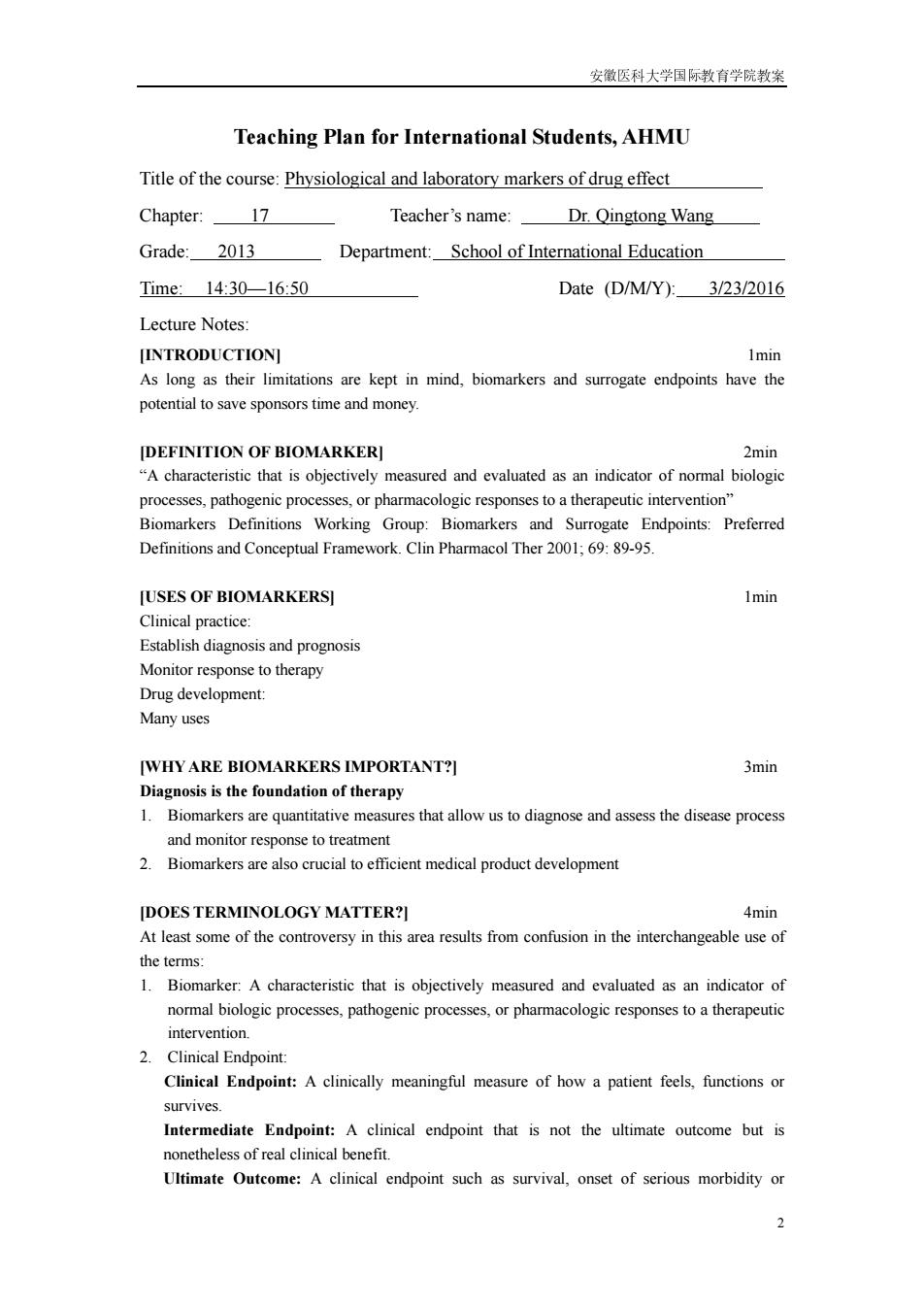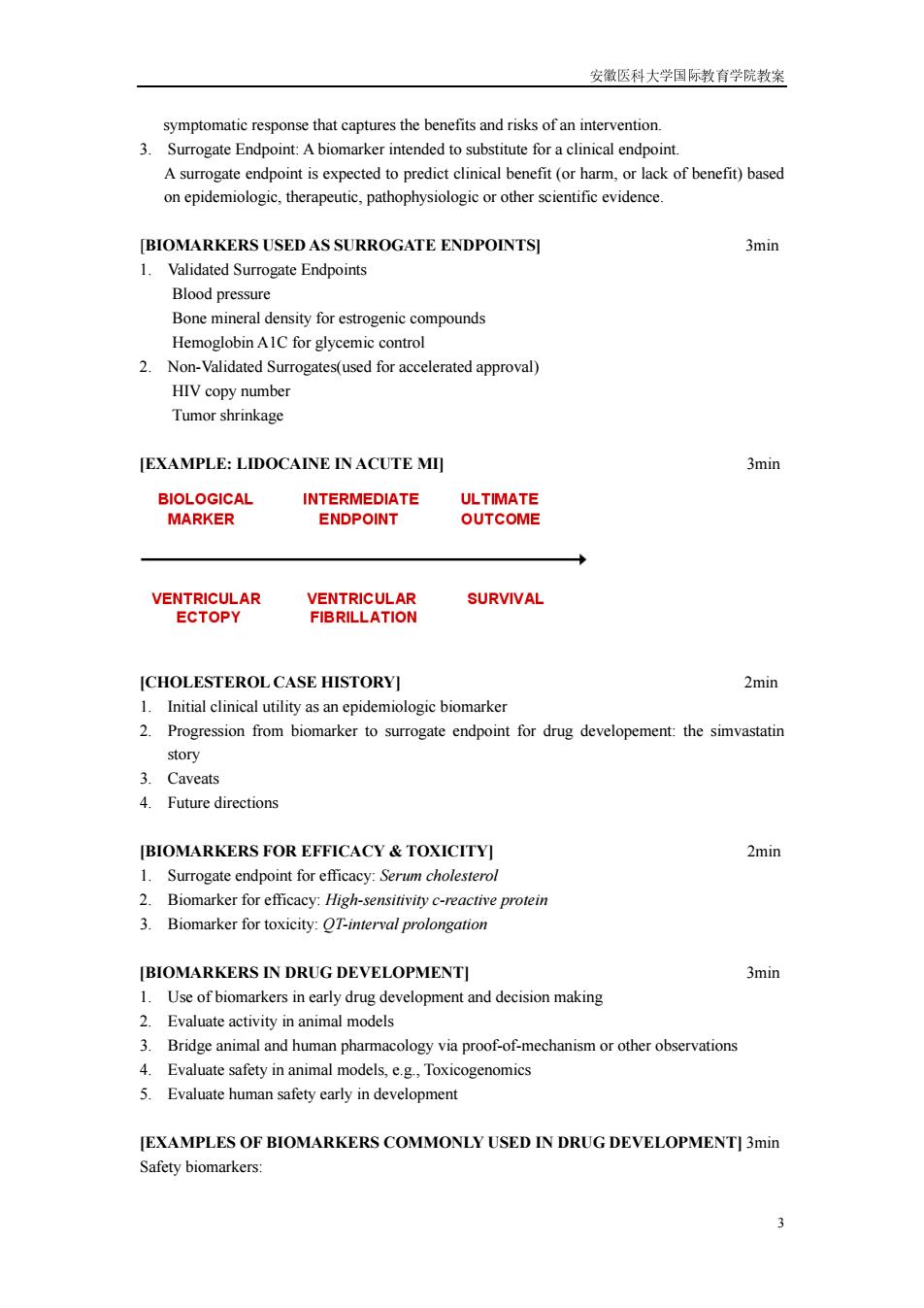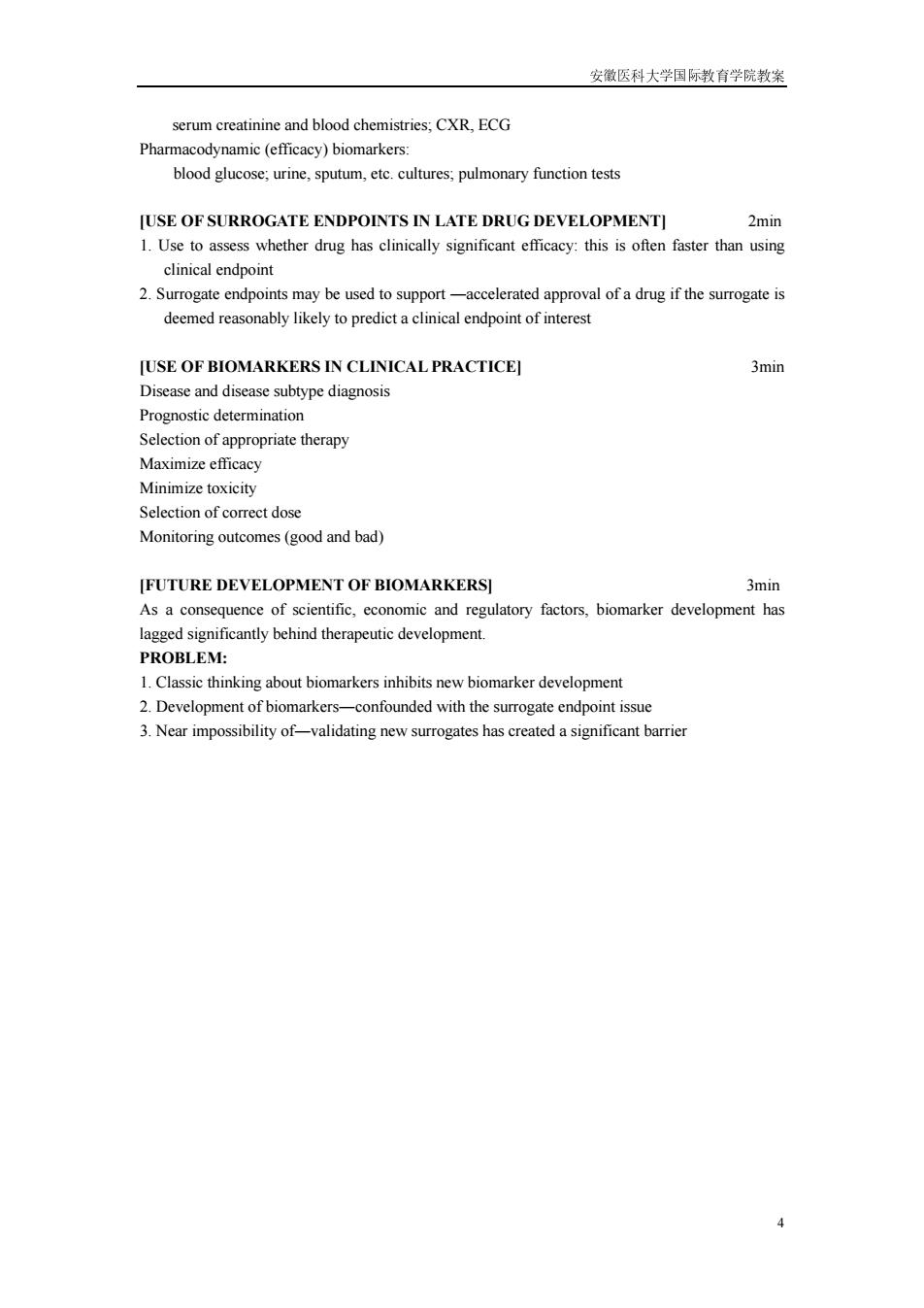
安徽医科大学国际教育学院教案 Teaching Plan for International Students,AHMU Title of the course:Physiological and laboratory markers of drug effect Chapter:_ 17 Teacher's name: Dr.Qingtong Wang Grade: 2013 Department:School of International Education Time:14:30-16:50 Date(D/M/Y):3/23/2016 Teaching 1.Master the concept of biomarker,clinical endpoints,and surrogate endpoint Objectives; 2.Recognize the function of biomarkers in drug efficacy toxicity Teaching 3.Recognize the use of biomarkers in drug development Requirements 4.Know the future development of biomarkers Teaching 1.Biological markers of drug effect Content 2.Biological markers in drug development 3.Future development of biomarkers Teaching Teaching Focus:The use of biomarkers in evaluating drug effects,toxicity Focus; and drug development. Difficult Difficult Problems:the concept and difference of biomarker,clinical endpoints,and surrogate endpoint.How the biomarker acts in the clinical Problems practice and their Solutions:Give examples of clinical drug use(the effect and toxicity events) Solutions and the use of biomarker.Compare the three words indetail. 1.The concept of biomarker,clinical endpoints,and surrogate endpoint 8min Time 2.Biological markers of drug effect 14min Allotment 3.Biological markers in drug development 10min 4.Future development of biomarkers 8min 1. The definition of Biomarker,Clinical Endpoint,Surrogate Endpoint, Assignment Intermediate Endpoint,Ultimate Outcome.Give examples. 2.The use of Biomarkers in drug development and clinical practice. 1.Principle of Clinical Pharmacology(Second Edition);ArthurJ.Atkinson Reference 2.Basic Clinical Pharmacology;Bertram G Katzung Text 3.Oxford Textbook of Clinical Pharmacology and Drug Therapy;David Grahame-Smith,Jeffrey Aronson Memo 1
安徽医科大学国际教育学院教案 1 Teaching Plan for International Students, AHMU Title of the course: Physiological and laboratory markers of drug effect Chapter: 17 Teacher’s name: Dr. Qingtong Wang Grade: 2013 Department: School of International Education Time: 14:30—16:50 Date (D/M/Y): 3/23/2016 Teaching Objectives; Teaching Requirements 1. Master the concept of biomarker, clinical endpoints, and surrogate endpoint 2. Recognize the function of biomarkers in drug efficacy & toxicity 3. Recognize the use of biomarkers in drug development 4. Know the future development of biomarkers Teaching Content 1. Biological markers of drug effect 2. Biological markers in drug development 3. Future development of biomarkers Teaching Focus; Difficult Problems and their Solutions Teaching Focus: The use of biomarkers in evaluating drug effects, toxicity and drug development. Difficult Problems: the concept and difference of biomarker, clinical endpoints, and surrogate endpoint. How the biomarker acts in the clinical practice Solutions: Give examples of clinical drug use (the effect and toxicity events) and the use of biomarker. Compare the three words indetail. Time Allotment 1. The concept of biomarker, clinical endpoints, and surrogate endpoint 8min 2. Biological markers of drug effect 14min 3. Biological markers in drug development 10min 4. Future development of biomarkers 8min Assignment 1. The definition of Biomarker, Clinical Endpoint, Surrogate Endpoint, Intermediate Endpoint, Ultimate Outcome. Give examples. 2. The use of Biomarkers in drug development and clinical practice. Reference Text 1. Principle of Clinical Pharmacology (Second Edition); ArthurJ. Atkinson 2. Basic & Clinical Pharmacology; Bertram G. Katzung 3.Oxford Textbook of Clinical Pharmacology and Drug Therapy; David Grahame-Smith, Jeffrey Aronson Memo

安徽医科大学国际教育学院教案 Teaching Plan for International Students,AHMU Title of the course:Physiological and laboratory markers of drug effect Chapter: 17 Teacher's name: Dr.Qingtong Wang Grade:2013 Department:School of International Education Time:14:30-16:50 Date (D/M/Y): 3/23/2016 Lecture Notes: [INTRODUCTION] 1min As long as their limitations are kept in mind,biomarkers and surrogate endpoints have the potential to save sponsors time and money. [DEFINITION OF BIOMARKER] 2min "A characteristic that is objectively measured and evaluated as an indicator of normal biologic processes,pathogenic processes,or pharmacologic responses to a therapeutic intervention" Biomarkers Definitions Working Group:Biomarkers and Surrogate Endpoints:Preferred Definitions and Conceptual Framework.Clin Pharmacol Ther 2001;69:89-95. JUSES OF BIOMARKERS] Imin Clinical practice: Establish diagnosis and prognosis Monitor response to therapy Drug development: Many uses [WHY ARE BIOMARKERS IMPORTANT?] 3min Diagnosis is the foundation of therapy 1.Biomarkers are quantitative measures that allow us to diagnose and assess the disease process and monitor response to treatment 2.Biomarkers are also crucial to efficient medical product development DOES TERMINOLOGY MATTER? 4min At least some of the controversy in this area results from confusion in the interchangeable use of the terms: 1.Biomarker:A characteristic that is objectively measured and evaluated as an indicator of normal biologic processes,pathogenic processes,or pharmacologic responses to a therapeutic intervention. 2.Clinical Endpoint: Clinical Endpoint:A clinically meaningful measure of how a patient feels,functions or survives. Intermediate Endpoint:A clinical endpoint that is not the ultimate outcome but is nonetheless of real clinical benefit. Ultimate Outcome:A clinical endpoint such as survival,onset of serious morbidity or 2
安徽医科大学国际教育学院教案 2 Teaching Plan for International Students, AHMU Title of the course: Physiological and laboratory markers of drug effect Chapter: 17 Teacher’s name: Dr. Qingtong Wang Grade: 2013 Department: School of International Education Time: 14:30—16:50 Date (D/M/Y): 3/23/2016 Lecture Notes: [INTRODUCTION] 1min As long as their limitations are kept in mind, biomarkers and surrogate endpoints have the potential to save sponsors time and money. [DEFINITION OF BIOMARKER] 2min “A characteristic that is objectively measured and evaluated as an indicator of normal biologic processes, pathogenic processes, or pharmacologic responses to a therapeutic intervention” Biomarkers Definitions Working Group: Biomarkers and Surrogate Endpoints: Preferred Definitions and Conceptual Framework. Clin Pharmacol Ther 2001; 69: 89-95. [USES OF BIOMARKERS] 1min Clinical practice: Establish diagnosis and prognosis Monitor response to therapy Drug development: Many uses [WHY ARE BIOMARKERS IMPORTANT?] 3min Diagnosis is the foundation of therapy 1. Biomarkers are quantitative measures that allow us to diagnose and assess the disease process and monitor response to treatment 2. Biomarkers are also crucial to efficient medical product development [DOES TERMINOLOGY MATTER?] 4min At least some of the controversy in this area results from confusion in the interchangeable use of the terms: 1. Biomarker: A characteristic that is objectively measured and evaluated as an indicator of normal biologic processes, pathogenic processes, or pharmacologic responses to a therapeutic intervention. 2. Clinical Endpoint: Clinical Endpoint: A clinically meaningful measure of how a patient feels, functions or survives. Intermediate Endpoint: A clinical endpoint that is not the ultimate outcome but is nonetheless of real clinical benefit. Ultimate Outcome: A clinical endpoint such as survival, onset of serious morbidity or

安徽医科大学国际教育学院教案 symptomatic response that captures the benefits and risks of an intervention. 3.Surrogate Endpoint:A biomarker intended to substitute for a clinical endpoint A surrogate endpoint is expected to predict clinical benefit(or harm,or lack of benefit)based on epidemiologic,therapeutic,pathophysiologic or other scientific evidence. [BIOMARKERS USED AS SURROGATE ENDPOINTSI 3min 1.Validated Surrogate Endpoints Blood pressure Bone mineral density for estrogenic compounds Hemoglobin AlC for glycemic control 2.Non-Validated Surrogates(used for accelerated approval) HIV copy number Tumor shrinkage [EXAMPLE:LIDOCAINE IN ACUTE MI 3min BIOLOGICAL INTERMEDIATE ULTIMATE MARKER ENDPOINT OUTCOME VENTRICULAR VENTRICULAR SURVIVAL ECTOPY FIBRILLATION CHOLESTEROL CASE HISTORY] 2min 1.Initial clinical utility as an epidemiologic biomarker 2.Progression from biomarker to surrogate endpoint for drug developement:the simvastatin story 3.Caveats 4.Future directions [BIOMARKERS FOR EFFICACY TOXICITY] 2min 1.Surrogate endpoint for efficacy:Serum cholesterol 2.Biomarker for efficacy:High-sensitivity c-reactive protein 3.Biomarker for toxicity:OT-interval prolongation [BIOMARKERS IN DRUG DEVELOPMENTI 3min 1.Use of biomarkers in early drug development and decision making 2.Evaluate activity in animal models 3.Bridge animal and human pharmacology via proof-of-mechanism or other observations 4.Evaluate safety in animal models,e.g.,Toxicogenomics 5.Evaluate human safety early in development [EXAMPLES OF BIOMARKERS COMMONLY USED IN DRUG DEVELOPMENT]3min Safety biomarkers: 3
安徽医科大学国际教育学院教案 3 symptomatic response that captures the benefits and risks of an intervention. 3. Surrogate Endpoint: A biomarker intended to substitute for a clinical endpoint. A surrogate endpoint is expected to predict clinical benefit (or harm, or lack of benefit) based on epidemiologic, therapeutic, pathophysiologic or other scientific evidence. [BIOMARKERS USED AS SURROGATE ENDPOINTS] 3min 1. Validated Surrogate Endpoints Blood pressure Bone mineral density for estrogenic compounds Hemoglobin A1C for glycemic control 2. Non-Validated Surrogates(used for accelerated approval) HIV copy number Tumor shrinkage [EXAMPLE: LIDOCAINE IN ACUTE MI] 3min [CHOLESTEROL CASE HISTORY] 2min 1. Initial clinical utility as an epidemiologic biomarker 2. Progression from biomarker to surrogate endpoint for drug developement: the simvastatin story 3. Caveats 4. Future directions [BIOMARKERS FOR EFFICACY & TOXICITY] 2min 1. Surrogate endpoint for efficacy: Serum cholesterol 2. Biomarker for efficacy: High-sensitivity c-reactive protein 3. Biomarker for toxicity: QT-interval prolongation [BIOMARKERS IN DRUG DEVELOPMENT] 3min 1. Use of biomarkers in early drug development and decision making 2. Evaluate activity in animal models 3. Bridge animal and human pharmacology via proof-of-mechanism or other observations 4. Evaluate safety in animal models, e.g., Toxicogenomics 5. Evaluate human safety early in development [EXAMPLES OF BIOMARKERS COMMONLY USED IN DRUG DEVELOPMENT] 3min Safety biomarkers:

安徽医科大学国际教育学院教案 serum creatinine and blood chemistries:CXR.ECG Pharmacodynamic(efficacy)biomarkers: blood glucose;urine,sputum,etc.cultures;pulmonary function tests JUSE OF SURROGATE ENDPOINTS IN LATE DRUG DEVELOPMENT] 2min 1.Use to assess whether drug has clinically significant efficacy:this is often faster than using clinical endpoint 2.Surrogate endpoints may be used to support-accelerated approval of a drug if the surrogate is deemed reasonably likely to predict a clinical endpoint of interest JUSE OF BIOMARKERS IN CLINICAL PRACTICE] 3min Disease and disease subtype diagnosis Prognostic determination Selection of appropriate therapy Maximize efficacy Minimize toxicity Selection of correct dose Monitoring outcomes(good and bad) FUTURE DEVELOPMENT OF BIOMARKERS] 3min As a consequence of scientific,economic and regulatory factors,biomarker development has lagged significantly behind therapeutic development. PROBLEM: 1.Classic thinking about biomarkers inhibits new biomarker development 2.Development of biomarkers-confounded with the surrogate endpoint issue 3.Near impossibility of-validating new surrogates has created a significant barrier 4
安徽医科大学国际教育学院教案 4 serum creatinine and blood chemistries; CXR, ECG Pharmacodynamic (efficacy) biomarkers: blood glucose; urine, sputum, etc. cultures; pulmonary function tests [USE OF SURROGATE ENDPOINTS IN LATE DRUG DEVELOPMENT] 2min 1. Use to assess whether drug has clinically significant efficacy: this is often faster than using clinical endpoint 2. Surrogate endpoints may be used to support ―accelerated approval of a drug if the surrogate is deemed reasonably likely to predict a clinical endpoint of interest [USE OF BIOMARKERS IN CLINICAL PRACTICE] 3min Disease and disease subtype diagnosis Prognostic determination Selection of appropriate therapy Maximize efficacy Minimize toxicity Selection of correct dose Monitoring outcomes (good and bad) [FUTURE DEVELOPMENT OF BIOMARKERS] 3min As a consequence of scientific, economic and regulatory factors, biomarker development has lagged significantly behind therapeutic development. PROBLEM: 1. Classic thinking about biomarkers inhibits new biomarker development 2. Development of biomarkers―confounded with the surrogate endpoint issue 3. Near impossibility of―validating new surrogates has created a significant barrier